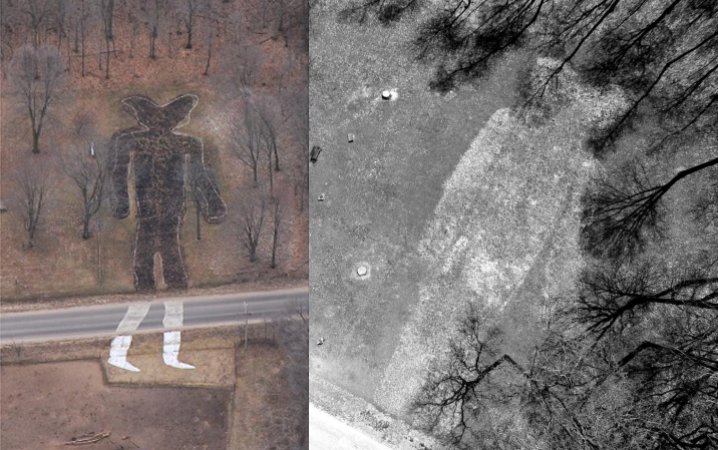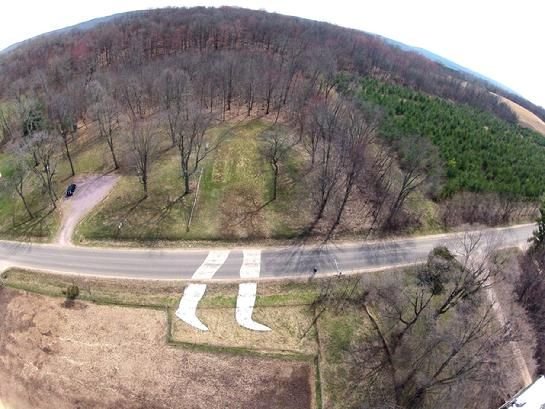Ancient Mystery Of The Man Mound And The Giant With Horns In Wisconsin
Ellen Lloyd - AncientPages.com - Ancient people left behind many structures and carvings that intrigue us, but it’s not always clear who made what, when, and why.
In North America, there are so many ancient mounds that hold vital clues to the past, but when trying to unravel some of their secrets we are often left with speculations and little facts. Perhaps that is what makes these ancient structures so interesting to us.
When investigating ancient mounds in North America archaeologists are often told by Native American tribes these structures are sacred to them, but they were not built by their people. Natives say these mounds have been there long before the Indians came to the area.
Who was the giant with horns and who were the people who made him? Left: Credit: Sauk County Wisconsin - Right: Credit: wiscnews
If the mounds were not built by Native Americans, then whose work are the effigy mounds? Are they the legacy of a long-lost ancient race we know basically nothing about?
Unfortunately study of the effigy mounds has been difficult because hundreds of the structures were deliberately destroyed when settlers moved into the region, but there are still some mounds that are as eye-catching as mysterious.
One of them is located in a tiny county park four miles northeast of Baraboo, Wisconsin. What makes this particular structure unique is the fact it’s the only surviving example of an anthropomorphic effigy mound. There were once five such mounds, but now we can only admire one.
Who made the prehistoric humanoid earthwork? What purpose did it serve? “Many who have written upon this subject, view these antiquities collectively as cemeteries; they suppose that when a location for sepulchral purposes was selected, the grounds in the vicinity were held sacred; that in constructing these tumuli, the material was brought from a distance, or collected in such a manner as to exhibit no indications of the adjacent soil having been removed; and as from the nature of the structure a constant disintegration took place, posterity were enjoined, as they wandered to and from, to add earth to the heap; - and they believe that by such means these monuments gradually rose into existence.
It’s very evident that these works were heaped up by a race that has long since passed away; as to the material of which they are constructed having been brought from a distance, we have no other testimony than conjecture.” 1
This is what we learn from an old historical document published in the American Journal of Science.
Today, scientists believe the Man Mound was constructed around 1000 A.D., about the time Leif Erikson sailed to America. The mound depicts a horned humanoid figure which has led to some speculations it was made in the image of a Viking, but they did not wear horned helmets.
It’s possible the two horns, may have been part of a ceremonial headdress. Could this be a depiction of an ancient shaman, or was it a god?
The ancient giant was partially destroyed. Credit: saukcountyhistory.org
The humanoid was originally was 214 feet (65 m) long and raised 2.5 feet (0.76 m) from the ground. Sadly, the legs and feet of the figure were destroyed by the construction of Man Mound Road and a cow pasture across the road, leaving the modern mound roughly 50 feet (15 m) shorter than its original length.
The giant humanoid is not so impressive when you study him from the ground, especially since the missing legs have had to be painted onto the road, but the sight of him from the air is quite remarkable.
The true identity of the humanoid giant in Wisconsin will probably never be revealed, but the effigy mound is of enormous historical importance which is why it was added to the National Register of Historic Places in 1978 and designated as a National Historic Landmark in 2016.
Written by Ellen Lloyd – AncientPages.com
Updated on July 20, 2024
Copyright © AncientPages.com All rights reserved. This material may not be published, broadcast, rewritten or redistributed in whole or part without the express written permission of AncientPages.com
Expand for references- Taylor, Stephen. "Description of ancient remains, animal mounds, and embankments: principally in the counties of Grant, Iowa, and Richland, in Wisconsin Territory." American Journal of Science, vol. 44 (1842): 21-40;
More From Ancient Pages
-
 New Unique Ancient Underwater Finds In The Ports Of Caesarea And Acre
Archaeology | Aug 11, 2021
New Unique Ancient Underwater Finds In The Ports Of Caesarea And Acre
Archaeology | Aug 11, 2021 -
 Egypt’s Dendera Temple: Second Restoration Phase Is Now Completed
Archaeology | Mar 6, 2021
Egypt’s Dendera Temple: Second Restoration Phase Is Now Completed
Archaeology | Mar 6, 2021 -
 Mount’s Bay, Lyonesse, Langarroc: Legendary Submerged Lands And Buried Towns Of Cornwall
Featured Stories | Apr 21, 2022
Mount’s Bay, Lyonesse, Langarroc: Legendary Submerged Lands And Buried Towns Of Cornwall
Featured Stories | Apr 21, 2022 -
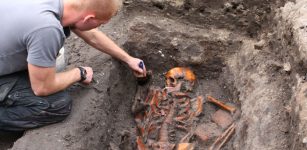 Evolution Of Plague Over Hundreds Of Years In Scandinavia Documented By Scientists
Archaeology | Feb 28, 2023
Evolution Of Plague Over Hundreds Of Years In Scandinavia Documented By Scientists
Archaeology | Feb 28, 2023 -
 Call Modern Humans Homo Faber, The Toolmaker – Not Homo Sapiens – Scientist Says
Archaeology | May 16, 2022
Call Modern Humans Homo Faber, The Toolmaker – Not Homo Sapiens – Scientist Says
Archaeology | May 16, 2022 -
 Are Priceless Ancient Gold Tablets Of The Serpent People Hidden Underground In Los Angeles?
Ancient Mysteries | May 24, 2014
Are Priceless Ancient Gold Tablets Of The Serpent People Hidden Underground In Los Angeles?
Ancient Mysteries | May 24, 2014 -
 Statues Of Serapis Sky God And Asclepios God Of Medicine Unearthed In Ancient City Of Kibyra
Artifacts | Nov 26, 2020
Statues Of Serapis Sky God And Asclepios God Of Medicine Unearthed In Ancient City Of Kibyra
Artifacts | Nov 26, 2020 -
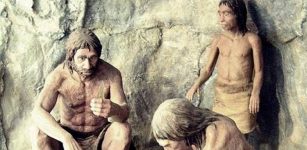 Modern Humans Used Favorable Climatic Conditions On Their Long Way From Africa To Europe
Archaeology | Oct 20, 2020
Modern Humans Used Favorable Climatic Conditions On Their Long Way From Africa To Europe
Archaeology | Oct 20, 2020 -
 Underground World Of Cerra Naztarny Where The Navajo And White People Once Lived Peacefully Together
Featured Stories | May 29, 2021
Underground World Of Cerra Naztarny Where The Navajo And White People Once Lived Peacefully Together
Featured Stories | May 29, 2021 -
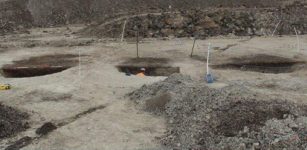 Significant Mesolithic Site With Unusual Pits Discovered In Bedfordshire
Archaeology | Jul 3, 2023
Significant Mesolithic Site With Unusual Pits Discovered In Bedfordshire
Archaeology | Jul 3, 2023 -
 Major Discovery Reveals Neanderthals In Italy Engaged In Plant Food Processing
Evolution | Jun 29, 2023
Major Discovery Reveals Neanderthals In Italy Engaged In Plant Food Processing
Evolution | Jun 29, 2023 -
 Colchester Vase Offers ‘Startling’ Evidence Of Gladiator Fights In Roman Britain
Archaeology | Mar 6, 2023
Colchester Vase Offers ‘Startling’ Evidence Of Gladiator Fights In Roman Britain
Archaeology | Mar 6, 2023 -
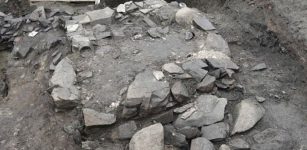 Is A Viking Settlement And Even Older Church Hidden Under St. Clement’s Church In Norway?
Archaeology | Apr 13, 2017
Is A Viking Settlement And Even Older Church Hidden Under St. Clement’s Church In Norway?
Archaeology | Apr 13, 2017 -
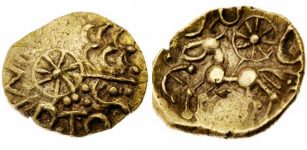 Ancient Coin Reveals Name Of Unknown British Iron Age King – Who Was ‘Esunertos’?
Archaeology | Oct 21, 2023
Ancient Coin Reveals Name Of Unknown British Iron Age King – Who Was ‘Esunertos’?
Archaeology | Oct 21, 2023 -
 Fisherman Pulls A Viking Sword From The River Cherwell, Oxford, UK
Archaeology | Mar 6, 2024
Fisherman Pulls A Viking Sword From The River Cherwell, Oxford, UK
Archaeology | Mar 6, 2024 -
 On This Day In History: First Battle Of Reading Took Place – On Jan 4, 871 AD
News | Jan 4, 2017
On This Day In History: First Battle Of Reading Took Place – On Jan 4, 871 AD
News | Jan 4, 2017 -
 On This Day In History: Tsar Peter The Great Opens New Chapter in Russia’s History – On Mar 19, 1697
News | Mar 19, 2017
On This Day In History: Tsar Peter The Great Opens New Chapter in Russia’s History – On Mar 19, 1697
News | Mar 19, 2017 -
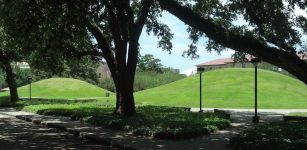 Mounds In Louisiana, North America Offer Insight Into Middle Archaic Lifestyles
Archaeology | Dec 2, 2022
Mounds In Louisiana, North America Offer Insight Into Middle Archaic Lifestyles
Archaeology | Dec 2, 2022 -
 Can Pollen Analysis Solve The Ice Age Mystery How And When Homo Sapiens Migrated Across Europe And Asia?
Archaeology | Sep 23, 2023
Can Pollen Analysis Solve The Ice Age Mystery How And When Homo Sapiens Migrated Across Europe And Asia?
Archaeology | Sep 23, 2023 -
 Unexpected Discovery Reveals People Arrived In North America 20,000 Years Earlier Than Previously Thought
Archaeology | Jun 5, 2021
Unexpected Discovery Reveals People Arrived In North America 20,000 Years Earlier Than Previously Thought
Archaeology | Jun 5, 2021

